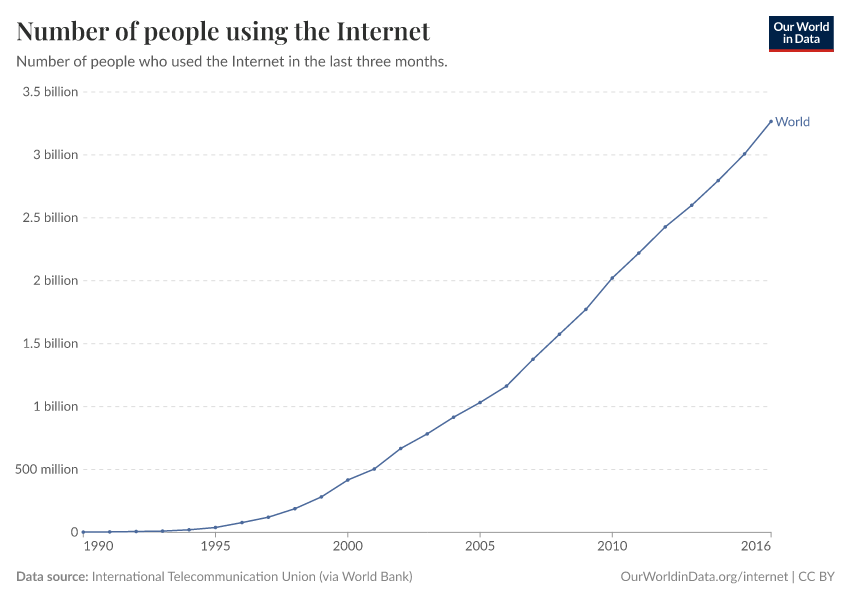Number of people using the Internet

What you should know about this indicator
- Population is the most commonly used metric throughout Our World in Data. It is used directly to understand population growth over time, and indirectly to calculate per-capita indicators, making it easier to compare countries of different sizes.
- We construct this indicator by combining multiple sources covering different periods.
- HYDE v3.3 (2023): historical estimates from 10,000 BCE to 1799.
- Gapminder v7 (2022): for 1800-1949.
- UN World Population Prospects (2024): for 1950 onwards, including 2100 projections.
- Gapminder Systema Globalis (2023): additional source for former countries (Yugoslavia, USSR, etc.)
- Breaks in the data may occur at the boundaries between sources due to their methodological differences.
- You can read more about the sources and methodology in our dedicated article. We also provide a table of sources showing the source we use for each country-year.
- We calculate geographical aggregates (continents, income groups, etc.) by summing individual country populations. For years before 1800, we rely directly on HYDE's values for continents to ensure historical consistency.
What you should know about this indicator
- Population is the most commonly used metric throughout Our World in Data. It is used directly to understand population growth over time, and indirectly to calculate per-capita indicators, making it easier to compare countries of different sizes.
- We construct this indicator by combining multiple sources covering different periods.
- HYDE v3.3 (2023): historical estimates from 10,000 BCE to 1799.
- Gapminder v7 (2022): for 1800-1949.
- UN World Population Prospects (2024): for 1950 onwards, including 2100 projections.
- Gapminder Systema Globalis (2023): additional source for former countries (Yugoslavia, USSR, etc.)
- Breaks in the data may occur at the boundaries between sources due to their methodological differences.
- You can read more about the sources and methodology in our dedicated article. We also provide a table of sources showing the source we use for each country-year.
- We calculate geographical aggregates (continents, income groups, etc.) by summing individual country populations. For years before 1800, we rely directly on HYDE's values for continents to ensure historical consistency.
Sources and processing
This data is based on the following sources
How we process data at Our World in Data
All data and visualizations on Our World in Data rely on data sourced from one or several original data providers. Preparing this original data involves several processing steps. Depending on the data, this can include standardizing country names and world region definitions, converting units, calculating derived indicators such as per capita measures, as well as adding or adapting metadata such as the name or the description given to an indicator.
At the link below you can find a detailed description of the structure of our data pipeline, including links to all the code used to prepare data across Our World in Data.
Notes on our processing step for this indicator
The number of internet users is calculated by Our World in Data based on internet access figures as a share of the total population, published in the World Development Indicators by the World Bank and total population figures from the UN World Population Prospects, Gapminder and HYDE."
Reuse this work
- All data produced by third-party providers and made available by Our World in Data are subject to the license terms from the original providers. Our work would not be possible without the data providers we rely on, so we ask you to always cite them appropriately (see below). This is crucial to allow data providers to continue doing their work, enhancing, maintaining and updating valuable data.
- All data, visualizations, and code produced by Our World in Data are completely open access under the Creative Commons BY license. You have the permission to use, distribute, and reproduce these in any medium, provided the source and authors are credited.
Citations
How to cite this page
To cite this page overall, including any descriptions, FAQs or explanations of the data authored by Our World in Data, please use the following citation:
“Data Page: Number of people using the Internet”, part of the following publication: Hannah Ritchie, Lucas Rodés-Guirao, Edouard Mathieu, Marcel Gerber, Esteban Ortiz-Ospina, Joe Hasell, and Max Roser (2023) - “Population Growth”. Data adapted from International Telecommunication Union (via World Bank), Various sources. Retrieved from https://auto-epoch.owid.pages.dev:8789/20250925-233948/grapher/number-of-internet-users.html [online resource] (archived on September 25, 2025).How to cite this data
In-line citationIf you have limited space (e.g. in data visualizations), you can use this abbreviated in-line citation:
HYDE (2023); Gapminder (2022); UN WPP (2024) – with major processing by Our World in DataFull citation
HYDE (2023); Gapminder (2022); UN WPP (2024) – with major processing by Our World in Data. “Number of people using the Internet” [dataset]. International Telecommunication Union (via World Bank), “World Development Indicators”; Various sources, “Population” [original data]. Retrieved November 1, 2025 from https://auto-epoch.owid.pages.dev:8789/20250925-233948/grapher/number-of-internet-users.html (archived on September 25, 2025).